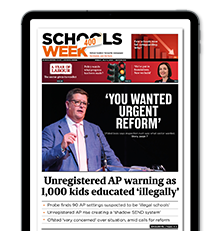An overdue transformation of early education won’t happen overnight, but two announcements this week mark an important statement of intent, reflecting an understanding at the highest levels of government that the consequences of the school-readiness crisis are catastrophic.
The prime minister’s new pledge that 75 per cent of children (up from 67 per cent at present) should achieve the ‘good level of development’ (GLD) at the end of reception is a very welcome commitment to the early years. However, the scale of the challenge is enormous and its causes are complex.
The fresh announcement from the education secretary Bridget Phillipson of increased funding is also an important step towards our nation reprioritising resources, time, attention and money on what are foundational years for educational success and life chances.
Children left behind at the age of three will be running uphill from then on. Those still stranded at the age of five risk being locked out of opportunity. The failure to invest in the early years means vast cost for the taxpayer later.
Increasing the early years pupil premium prioritises the children who need support the most, but it’s still far short of the primary top-up rate.
Five years of our research show that high levels of parental uncertainty about expectations of early child development are stubbornly high. Too many parents simply don’t know what being ready for school means developmentally, making the new target even more challenging.
Access to high-quality nursery places is patchy, with underpaid staff difficult to recruit and retain. The current funding of nursery entitlements favours working mothers going back to well-paid work over the development needs of children who, statistically speaking, benefit most from high-quality childcare.
The cost of living and the breakdown of extended family structures mean parents face huge pressures, and looking after babies and toddlers is hard – joyful, yes of course, but also exhausting and challenging.
The problem is being defined in apples but the target is fixed in pears
Meanwhile, cuts to services, a 40-per cent reduction in health visitors since 2015 and the closure of integrated services provision through SureStart risk new parents becoming isolated from sources of advice and guidance.
Much has been written about the need for the state to grip the funding, quality, staffing and access problems facing the childcare sector. But to focus only on nurseries overlooks the truth that the biggest and most important influence on child development is what happens at home.
Parents are a child’s first educators. The concerted efforts of even the very best nurseries can’t alone support children’s development without the engagement of informed parents. But who is teaching them?
Ask lots of parents (and we have) how they define the first day of school and, funnily enough, they overwhelmingly say it’s day one of reception year. That’s the point at which our research is focused, and we’ve been delighted at the extensive use of this data in the government’s explanation of the new school-readiness target, repeated across multiple media outlets.
However, the new 75 per cent pledge is based not on this definition of school readiness, but on the GLD which is assessed at the end of reception. The problem is being defined in apples but the target is fixed in pears.
Parents need straightforward information. Muddling measures of two different points of development doesn’t help. In addition, conflating our data and the GLD target overlooks the essential work by hard-working reception teachers and their assistants facing the real challenge of school readiness.
They are the ones faced with one-third of children unable to dress or feed themselves independently, one in four not yet toilet-trained and more than one in three unable to follow a simple instruction.
The real figure of children who are school-ready when they first enter school is far from 67 per cent; it’s closer to half. It’s thanks to the efforts of reception teams that the number is as high as 67 per cent by the time pupils start Year 1.
If primary school budgets, leadership and reception teams are to stand a fighting chance of delivering on the 75 per cent target, we must all work together. That starts with being honest about the scale of the challenge and open about expectations and parental responsibility.
We need to find a way to talk about the importance of great parenting without fear of sounding like an interfering ‘nanny state’. While celebrating today’s announcement of additional funding, we need to encourage policy-makers to go further, faster to ensure schools can focus time and budgets on teaching rather than closing a development gap that’s too big for even the most heroic reception teams to bridge.
Rome wasn’t built in a day, but this has been a good day the prioritisation of early year development. I hope it’s just the beginning.












Parental rsponsibility is a key issue that is constantly skirted around and it’s great to finally see some mention of it.
We are an inner city school with a strong nursery provision. We struggle to get to 65% of children at a good level of development by the end of reception. Our intake of children who did not attend nursery always heavily populates the group who do not achieve GDL. In many cases, these are children allocated to us, whose parents did not apply for a school place. These children slip through the net. In the past, health visitors would have been drivers in the process of getting many more of these children into nursery, let alone reception.
On a separate note, Surestart did some fantastic work to support many struggling families. However, there was a downside in the culture of parental dependency that accompanied this and which is still very evident. We don’t draw too many conclusions, as this is a real chicken-and-egg debate. Nonetheless, it should be explored as a factor when considering school readiness.